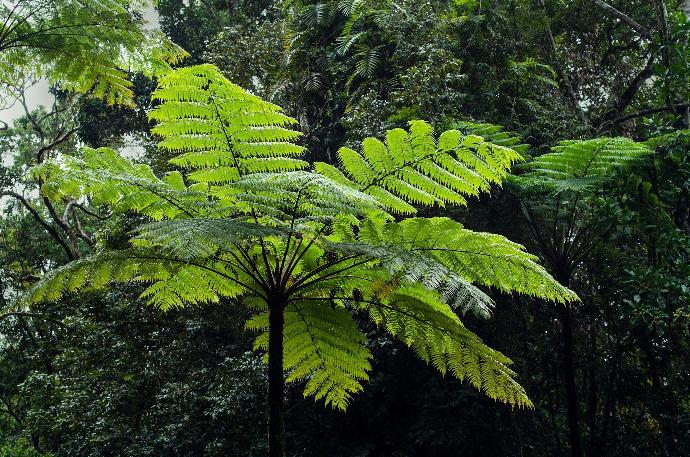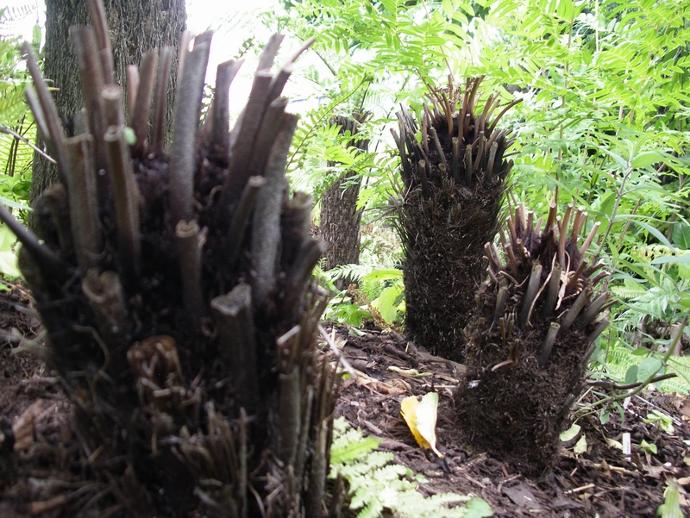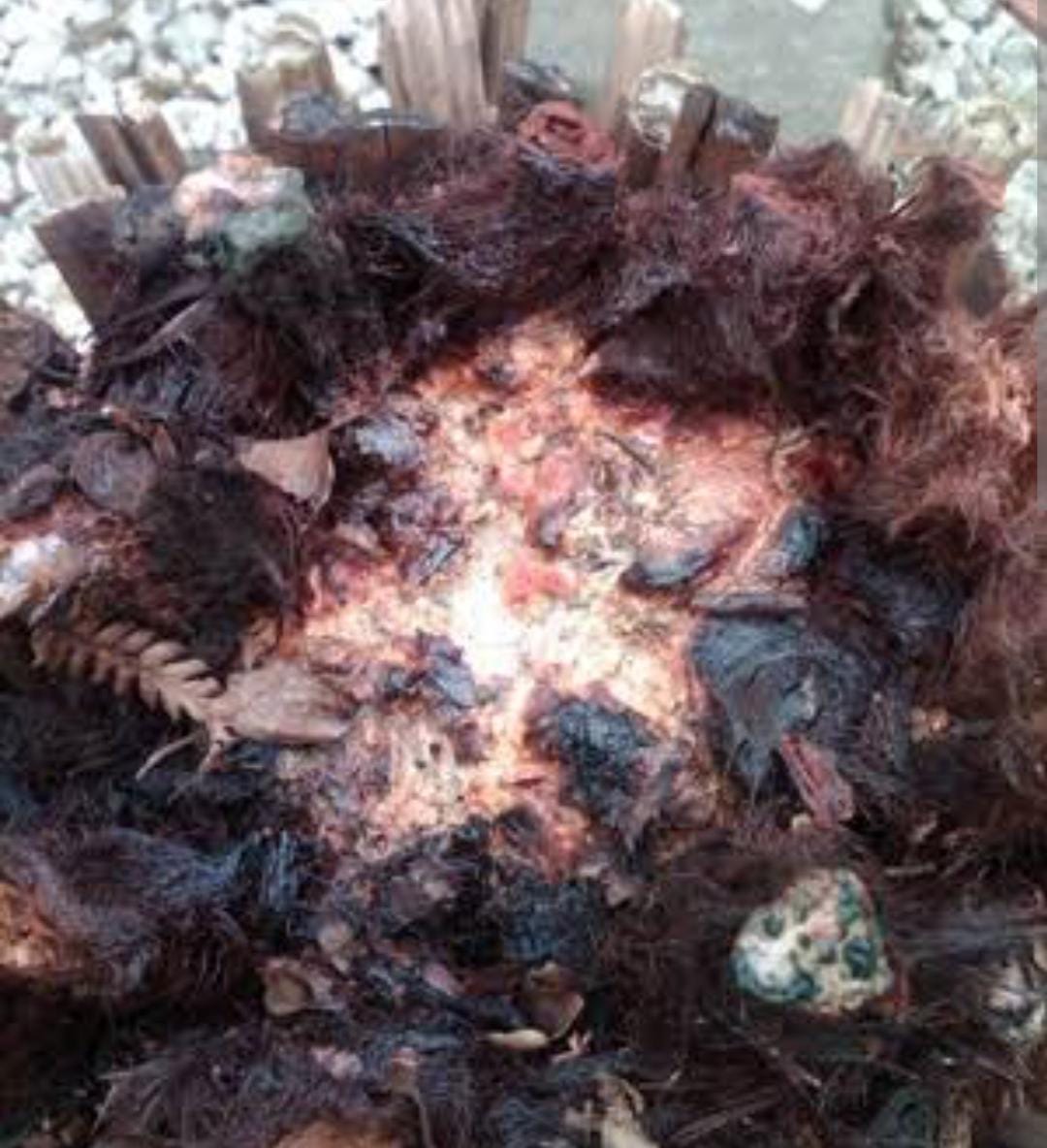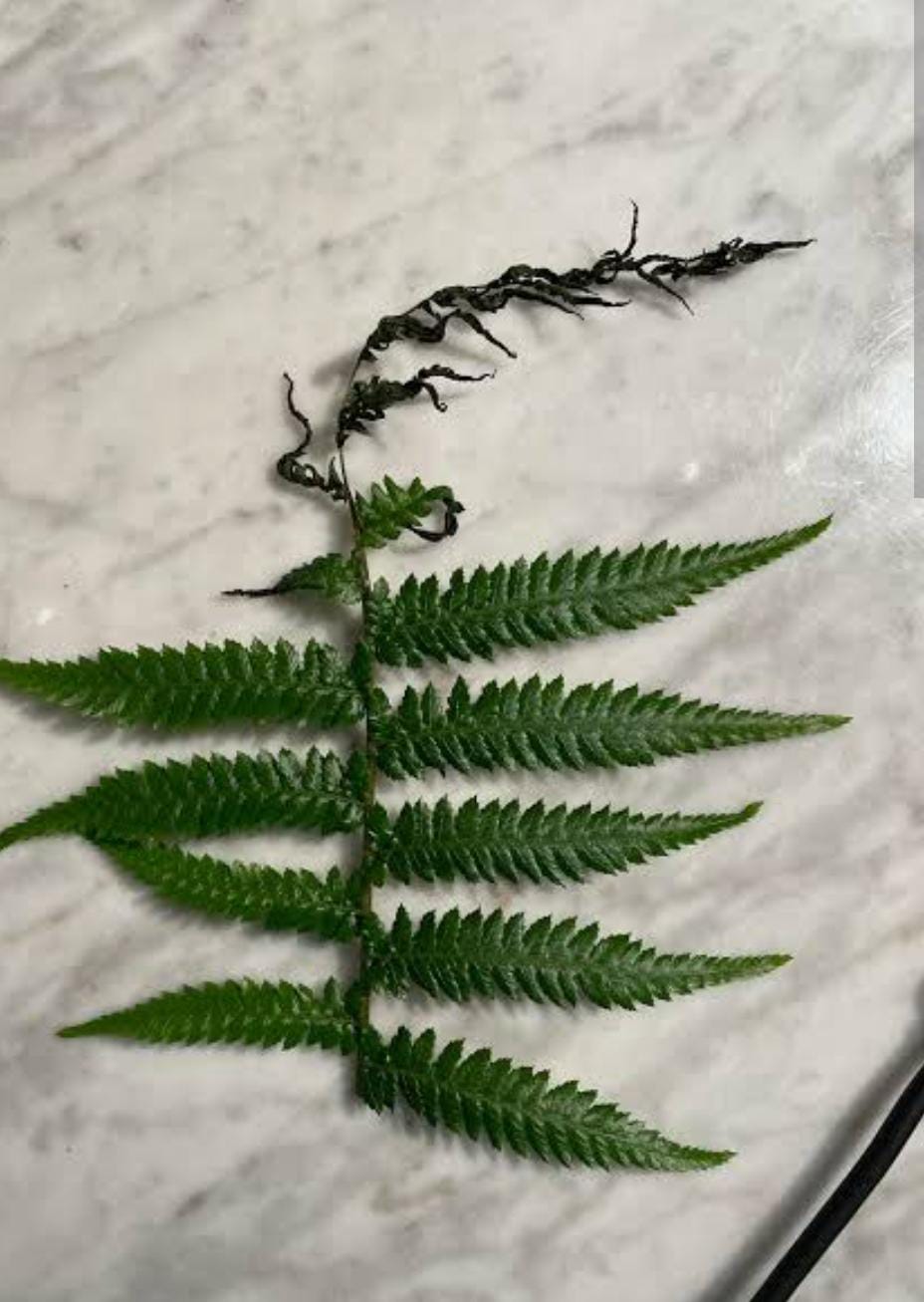Tree Fern Plant
Tree Fern, a type of fern, may have varying care requirements. Generally, plant in well-draining soil with high organic matter. Provide partial to full shade and keep the soil consistently moist. Pruning may involve removing old or unsightly fronds. Protect from strong winds.

Habit
Annual / Perennial
Height
2 to 3 m
Growth
Moderate
Soil
Well-drained, Loamy
Shade
Partial Shade
Moisture
Moist
Edible
No
Medicinal
No
Origin
Australia, New Zealand
Climatic Condition
Tropical, Subtropical
Temperature (°)
20°C to 30°C
Humidity (%)
60% to 80%
Potting media
50% Loam, 40% Sand, 10% Organic Matter
Fertilizers
Organic Fertilizer
Watering
Regular watering
Plant Weight
3 to 6 kg
Flowering Time
Spring to Fall
Soil Ph level
6.0 to 7.0
Water Ph level
6.0 to 7.5
Soil EC
0.5 to 0.7 mS/cm
Yield Per Plant
5 to 10 kg per plant
NPK ratio
15:5:10
life Span
5 to 10 years
Health Benefits
Ornamental, Air-purifying
Suggested Grow Media or Potting Mix ?
50% peat moss, 30% perlite, 20% compost
Suggested Fertigation/Fertilizers
Fertilize every 4 weeks with a balanced, water-soluble fertilizer.
Common Diseases and Remedies
Crown Rot , Root rot
Tree appears to wither and die suddenly. The fruiting bodies of the fungi (mushrooms) may appear on the soil around the base of the tree.
Prune infected plant parts .
HEALTH BENEFITS
1. May help reduce inflammation: Tree fern's antioxidants and other compounds may help reduce inflammation and improve overall health.
2. May have antimicrobial properties: Tree fern may have antimicrobial properties that can help prevent infections.
3. May help improve respiratory health: Tree fern's antioxidants and other compounds may also help improve respiratory health.
What is a tree fern?
The tree fern is an ancient plant in the Asteraceae family that is characterized by a tall, slender trunk and large feather-like leaves. These ferns are primarily found in tropical and subtropical regions and thrive in moist, shady environments such as rainforests, often growing in the understory.
What types of tree ferns are there?
1. *Dicksonia antarctica*:
Also known as the soft tree fern or Tasmanian tree fern, this species is native to southeastern Australia and Tasmania. It is one of the most commonly cultivated tree ferns due to its hardiness and attractive appearance.
2. *Cyathea cooperi*:
Native to Australia and commonly known as the Australian tree fern, Cyathea cooperi is characterized by its large, arching fronds and slender trunk. It is often grown as an ornamental plant in gardens and landscapes.
3. *Cyathea australis*:
Another species native to Australia, the Cyathea australis or rough tree fern has a characteristic rough texture on its trunk due to the bases of older leaves. It prefers moist, shady environments and is often found in tropical rainforests.
4. *Cyathea medullaris*:
Also known as the black tree fern or mamaku, this species is native to New Zealand and is one of the largest tree ferns, with leaves up to 6 meters (20 feet) long. It is highly valued in Maori culture for its medicinal properties and cultural importance.
5. *Cyathea Brownii*:
Cyathea Brownii or Norfolk tree fern is native to Norfolk Island in the South Pacific and has a slender trunk and glossy dark green leaves. Although endangered in the wild, it is cultivated in gardens and plant collections.
How to care for tree fern plant ?
Location
Tree fern plants thrive in locations with specific environmental conditions that mimic their natural habitats. Here are the key requirements for growing tree ferns successfully:
1. *Shade*: Tree ferns are understory plants, meaning they grow beneath the canopy of larger trees in their native habitats. They prefer filtered or indirect sunlight rather than direct sunlight, as too much sun can scorch their delicate fronds. It is important to plant in a shady location or provide shade from tall plants or structures.
2. *Moisture*: Tree ferns require consistently moist soil to grow. They are adapted to high humidity environments and require sufficient water to support their growth. Regular watering is important, especially during dry periods. It also benefits from a well-drained soil mix that retains moisture without causing flooding.
Sunlight
Ferns prefer shaded or partially shaded environments to direct sunlight. Photosynthesis requires some light, but strong sunlight can damage delicate leaves. Ideally, tree ferns should be placed in areas that receive filtered or indirect sunlight, such as under the canopy of a tall tree or in an area with dappled light.
Soil
Tree ferns thrive in soils that are rich in organic matter, well-drained, and highly water-holding. The main characteristics of ideal soil for tree ferns are:
1. *Water Retention*: Tree ferns require consistently moist soil to grow. The soil must have the ability to retain moisture without causing flooding. Adding organic matter to the soil, such as compost, peat moss, and well-rotted manure, can improve the soil's water-holding capacity.
2. *Well-draining*: While tree ferns need moist soil, they are susceptible to root rot if the soil becomes waterlogged. Therefore, it's important to ensure that the soil has good drainage to prevent water from pooling around the roots. Adding perlite, coarse sand, or gravel to the soil mix can help improve drainage.
Hydration
Tree ferns require consistent hydration to thrive, as they are adapted to moist environments. Here are some key points regarding hydration for tree fern plants:1. *Regular watering*: Tree ferns prefer evenly moist soil. Depending on the climate and environmental conditions, regular watering may be necessary, especially during dry periods. It's important to monitor soil moisture levels and water your plants when the top few inches of soil feel dry.
2. *Avoid waterlogging*: Tree ferns require plenty of water, but it is important to avoid waterlogging the soil as this can cause root rot and other problems. Choose soil with good drainage to prevent water from pooling around the roots. Water deeply and occasionally, allowing the soil to dry slightly between waterings.
Nourishment
Tree ferns require adequate nutrition to support their growth and development. Here are some important aspects of tree fern nutrition.
1. *Fertilization*: Tree ferns benefit from regular fertilization to replenish nutrients in the soil. Use a balanced, slow-release fertilizer designed for ferns and acid-loving plants. Apply fertilizer according to the manufacturer's instructions during the growing season, usually from spring to early fall. Avoid over-fertilizing as this can upset the nutritional balance and burn the roots of the plant.
2. *Organic Matter*: Incorporating organic matter into soil provides important nutrients and improves soil structure. Mix compost, well-rotted manure, or leaf mold into the soil before planting tree ferns to enrich the soil and support healthy growth.
*Pests*: Tree ferns may be susceptible to pests such as scale insects, mealybugs, aphids, and slugs. Inspect the plant regularly for signs of pest infestation, such as distorted foliage, sticky residue, or visible pests, and take appropriate measures to control pests, such as handpicking, insecticidal soap, or neem oil.
5. *Diseases*: Tree ferns can be susceptible to fungal diseases such as root rot, leaf spot, and powdery mildew, especially in humid or poorly ventilated conditions. To prevent the spread of disease, avoid overwatering, improve air circulation around the plant, and remove and dispose of infected leaves immediately.
What are the benefits of tree ferns?
Tree ferns offer several benefits to both the environment and the gardener. Some of the main benefits of tree ferns are listed below.
1. *Aesthetic Appeal*: Tree ferns add tropical elegance to gardens and landscapes with their graceful foliage and unique trunks. The architectural shape and lush foliage make it an attractive focal point or outdoor accent plant.
2. *Air Purification*: Like other plants, tree ferns improve air quality by absorbing carbon dioxide and releasing oxygen during photosynthesis. It also helps filter pollutants and toxins from the air, contributing to a cleaner, healthier environment.
3. *Shade and Cooling*: The dense foliage of tree ferns provides shade and helps reduce the temperature of the surrounding area. Strategically planted tree ferns can create a cool microclimate in your garden or outdoor living area, providing relief from the heat during hot summer months.
4. *Wildlife Habitat*: Tree ferns provide habitat and food for a variety of wildlife species, including insects, birds, and small mammals. The dense foliage provides shelter and nesting sites for birds, and the trunk and leaf litter provide habitat for insects and other small creatures.
5. *Soil Erosion Control*: The fibrous root system of tree ferns stabilizes the soil and prevents erosion on slopes and erosion-prone areas. Planting tree ferns on slopes and riverbanks helps reduce soil erosion and protect fragile landscapes.
Frequently asked questions about growing tree ferns?
How do I care for my tree fern?
1. *Water*: Regularly water your tree fern , water to maintain consistent soil moisture, especially during dry periods. Make sure the soil is evenly moist and not soggy. Monitor soil moisture levels and adjust watering frequency based on environmental conditions.
2. *Fertilization*: Apply a balanced, slow-release fertilizer designed for ferns or acid-loving plants during the growing season (spring through early fall) to replenish soil nutrients. Follow the manufacturer's instructions for fertilization amount and frequency to avoid over-fertilizing.
3. *Mulching*: Apply a layer of organic mulch around the base of the tree fern to retain soil moisture, suppress weeds, and gradually enrich the soil. Replenish the mulch layer as needed to maintain a depth of 2 to 3 inches.
4. *Pruning*: Regularly remove dead or damaged leaves to maintain the plant's appearance and promote healthy growth. Use clean, sharp pruning shears to cut cleanly and avoid damaging the remaining leaves.
5. *Frost Protection*: If you grow tree ferns in areas with cold winters, protect them from frost during the cold season to prevent damage from sub-zero temperatures. If frost is expected, cover the plant with frost cloth or move it to a protected location.
What is the purpose of tree ferns?
1. *Ornamental Landscaping*: Tree ferns are popular ornamental plants in gardens and landscapes, prized for their graceful foliage, architectural shape, and tropical appearance.
2. *Indoor Decoration*: Certain types of tree ferns, such as: Some plants, such as dwarf and miniature varieties, are suitable for indoor cultivation and are used as houseplants and interior decoration.
3. *Medicinal*: In some cultures, tree ferns are traditionally used as medicines, with different parts of the plant used to treat ailments such as wounds, skin diseases, and rheumatism.
4. *Cultural Significance*: Tree ferns have cultural or ceremonial significance in certain indigenous communities and may be used in ceremonies, ceremonies, or traditional practices. In some cultures, tree ferns are considered sacred or symbolic of certain cultural values and beliefs.
5. *Habitat Improvement*: Tree ferns provide habitat and food for a variety of wildlife species, including insects, birds, and small mammals. Dense foliage provides shelter and nesting sites for birds, while trunks and leaf litter provide habitat for insects and other small creatures, contributing to biodiversity and ecosystem health.
Can I grow tree ferns indoors?
1. *Light*: Tree ferns usually prefer bright, indirect light. Place it near a north or east window so it receives sunlight all day long. Avoid exposing it to direct sunlight as it can burn the delicate leaves.
2. *Humidity*: Tree ferns grow in humid environments. Indoor air tends to be dry, especially in the winter when heating systems are running. Increase the humidity around your tree fern by misting the foliage regularly or by placing a humidifier nearby
3. *Temperature*: Most tree fern species prefer warm temperatures, but will tolerate cooler conditions as long as there is no frost. Keep the indoor temperature between 15 and 27 degrees Celsius during the day and avoid exposing your plants to drafts or sudden temperature changes.
4. *Watering*: Keep the soil evenly moist but not soggy. Water your tree fern when the top of the soil feels dry, allowing excess water to drain freely from the bottom of the pot. Avoid overwatering as this may cause root rot.
Which pot is best for growing tree ferns?
When choosing a pot for growing tree ferns, consider size, material, drainage, and aesthetics. It is important to consider factors such as: Here are some guidelines for choosing the best pot for growing your tree fern.
1. *Size*: Choose a pot slightly larger than the plant's root ball to allow room for growth. Because tree ferns have fibrous roots that spread out laterally, they do better in wide pots rather than deep pots. A pot that is 1 to 2 inches larger in diameter than the root ball is generally suitable for most tree ferns.
2. *Material*: Choose pots made from breathable, porous materials such as terracotta, ceramic, or unglazed clay. These materials allow air and moisture to flow around the sides of the pot, promoting healthy root growth and preventing soil flooding. Avoid plastic pots as they tend to trap moisture and poor drainage can cause root rot.
3. *Drainage*: Make sure there are proper drainage holes in the bottom of the pot so that excess water can drain freely.
4. *Weight*: Consider the weight of the pot, especially if you will be moving it frequently or placing it on a balcony or elevated location. Terracotta and ceramic pots are generally heavier than plastic pots. Therefore, choose a pot that is easy to use and suits your needs.
Where can I buy tree ferns?
1. *Local nursery*: A local nursery or garden center in your area that specializes in tropical plants and ferns. visit. You may have a variety of tree ferns that are suitable for your climate and growing conditions. Childcare staff can also provide expert advice on care and maintenance.
2. *Online Plant Retailers*: Many online plant retailers have a wide range of tree fern species available for purchase, including dwarf varieties suitable for indoor cultivation. Look for reputable online stores with positive reviews and a large selection of healthy plants. Please be sure to read the product description and delivery terms carefully before purchasing.
3. *Botanical Gardens*: Some botanical gardens and arboretums offer online stores where you can purchase propagated tree ferns from their plant sales or collections. By supporting botanical gardens, you not only preserve high-quality plants, but also fund plant conservation and education efforts.
4. *Specialist Fern Nurseries*: Specialized nurseries with a special focus on ferns can offer a wide variety of tree fern species, including rare and exotic varieties. Search online for fern nurseries in your area or contact your local plant association for recommendations.


